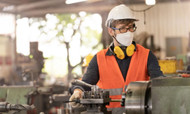Common Types of Workplace Airborne Contaminants
Posted by William Kimmell on 24th Feb 2022
Industrial workplaces can emit a variety of potential irritants into the air or require workers to operate near fumes and gases. You should be mindful of any possible harmful emissions that you might encounter so you can take the necessary precautions. Look below to discover the most common types of workplace airborne contaminants you should avoid.
Dust and Particulates
Normal industrial processes such as grinding, sanding, and blasting will inevitably cause dust and particulate to kick up into the surrounding environment. While these particles are ubiquitous, they may quickly turn from an irritation to a significant health concern at higher concentrations. Metallic dust, organic dust, and mineral fibers are all common in industrial workplaces and dangerous when you inhale massive quantities.
Aerosol Misting
Aerosol mists are liquid droplets generated by processes that dissolve water into finely fragmented particles or evaporation and condensation back into droplets. Common causes of workplace mist include spray painting, welding, laser cutting, CNC machines, and other processes that discharge water or other fluids. Most droplet sizes are relatively small, yet they can contain compounds that are highly hazardous when inhaled, such as neurotoxins and carcinogens.
Hazardous Vapors
Vapors get emitted from the surfaces of liquids and behave similarly to gases but are more likely to condense into droplets. Some compounds require heat to create vapor, whereas others quickly evaporate at room temperature. Inhaling vapor can aggravate your airways, skin, and eyes, and it can leave your nose and throat sore or inflamed.
Gases and Fumes
Gas can leak into the air due to many different processes, such as damage to gas lines or burning fuel. Inert gases can swiftly displace air in a vast area, resulting in an oxygen-deficient atmosphere; toxic gases can generate poisonous environments; combustible or reactive gases can cause fires and cylinder explosions. Workers can pass out or even die from suffocation or poisoning after inhaling noxious gases.
It’s crucial to take the proper precautions to avoid the most common types of workplace airborne contaminants. Wearing the right respiratory protection equipment before handling hazardous materials or entering dangerous environments should be your first line of defense. You can find the best safety equipment, such as chemical suits and respirators, through the TG Technical Services website.

